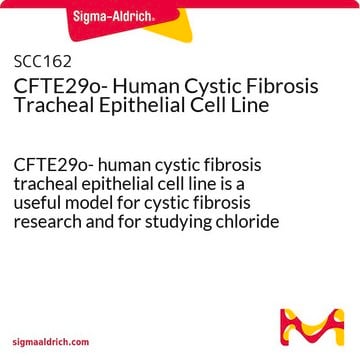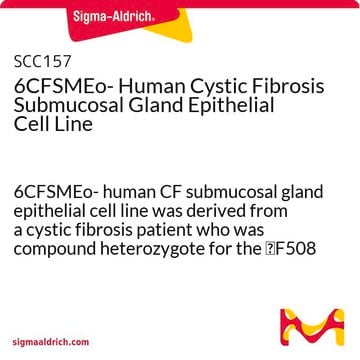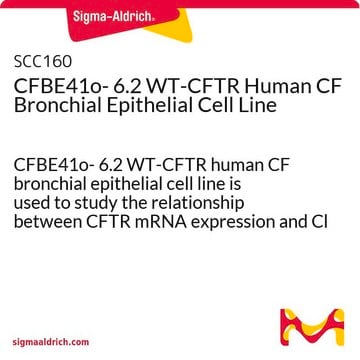SCC155
CFSMEo- Human Cystic Fibrosis Submucosal Gland Epithelial Cell Line
Human
Synonim(y):
CFSMEO
About This Item
Polecane produkty
product name
CFSMEo- Human Cystic Fibrosis Submucosal Gland Epithelial Cell Line, CFSMEo- human CF submucosal gland epithelial cell line was derived from a cystic fibrosis patient who was compound heterozygote for the ΔF508 and Q2X CFTR mutations.
pochodzenie biologiczne
human
metody
cell based assay: suitable
cell culture | mammalian: suitable
Warunki transportu
ambient
Opis ogólny
CFSMEo- is a human tracheobronchial submucosal gland epithelial cell line isolated from an individual with CF, who was compound heterozygote for the ΔF508 and Q2X CFTR mutations . ΔF508 mutation is a trinucleotide deletion that results in loss of a phenylalanine at amino acids 508 (ΔF508) in the CFTR protein. This mutation accounts for ~66% of all CF alleles . Q2X mutation is a rare CF mutation in exon 1 of the CFTR gene in which the second codon (CAG) is mutated into the stop codon UAG. The CFSMEo- cell line is the result of pooled colonies that arose from immortalization of the human CF tracheobronchial submucosal gland cells with the origin-of-replication defective SV40 plasmid (pSVori-) .
CFSMEo- retains the characteristic cobblestone morphology of epithelial cells along with cytokeratin expression and the ability to form tight junctions. The cell line expresses vestigial amounts of CFTR mRNA transcripts but does not express detectable levels of CFTR protein . CFSMEo- lacks cAMP-induced Cl- currents .
Opis linii komórkowej
Zastosowanie
Jakość
• Cells are tested by PCR and are negative for HPV-16, HPV-18, Hepatitis A, C, and HIV-1 & 2 viruses as assessed by a Human Essential CLEAR panel by Charles River Animal Diagnostic Services.
• Cells are negative for mycoplasma contamination.
• Each lot of cells is genotyped by STR analysis to verify the unique identity of the cell line.
Przechowywanie i stabilność
Oświadczenie o zrzeczeniu się odpowiedzialności
Unless otherwise stated in our catalog or other company documentation accompanying the product(s), our products are intended for research use only and are not to be used for any other purpose, which includes but is not limited to, unauthorized commercial uses, in vitro diagnostic uses, ex vivo or in vivo therapeutic uses or any type of consumption or application to humans or animals.
Kod klasy składowania
10 - Combustible liquids
Klasa zagrożenia wodnego (WGK)
WGK 1
Temperatura zapłonu (°F)
Not applicable
Temperatura zapłonu (°C)
Not applicable
Certyfikaty analizy (CoA)
Poszukaj Certyfikaty analizy (CoA), wpisując numer partii/serii produktów. Numery serii i partii można znaleźć na etykiecie produktu po słowach „seria” lub „partia”.
Masz już ten produkt?
Dokumenty związane z niedawno zakupionymi produktami zostały zamieszczone w Bibliotece dokumentów.
Produkty
16HBE14o- human bronchial epithelial cells used to model respiratory epithelium for the research of cystic fibrosis, viral pulmonary pathology (SARS-CoV), asthma, COPD, effects of smoking and air pollution. See over 5k publications.
16HBE14o- ludzkie komórki nabłonka oskrzeli wykorzystywane do modelowania nabłonka oddechowego w badaniach nad mukowiscydozą, wirusową patologią płuc (SARS-CoV), astmą, POChP, skutkami palenia tytoniu i zanieczyszczenia powietrza. Zobacz ponad 5 tys. publikacji.
Nasz zespół naukowców ma doświadczenie we wszystkich obszarach badań, w tym w naukach przyrodniczych, materiałoznawstwie, syntezie chemicznej, chromatografii, analityce i wielu innych dziedzinach.
Skontaktuj się z zespołem ds. pomocy technicznej







